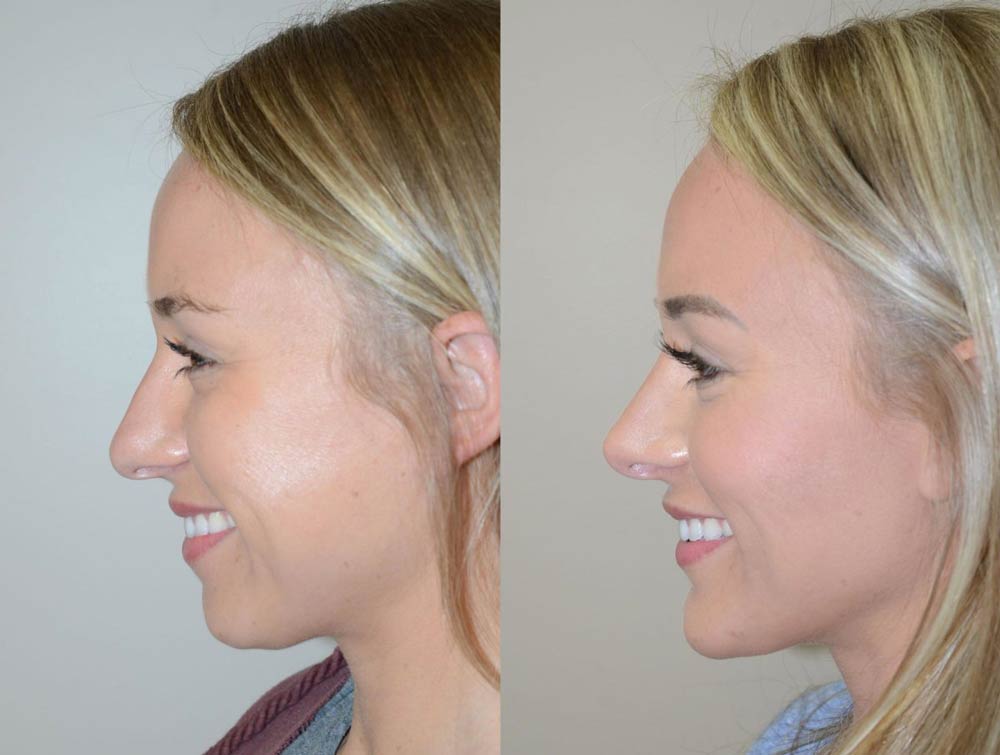
Fleshy Nose Surgery
A fleshy (bulbous) nose is characterized by thick skin and weak, thin cartilage. Traditional surgical techniques were often ineffective for this type of nose, as shaving down the cartilage caused it to eventually revert to its previous shape. Today, however, rhinoplasty techniques involve strengthening the nasal cartilage and reinforcing the nasal structure while shaping the nose, which significantly improves results and minimizes the risk of drooping or reversion. In this modern approach, cartilage is taken from the nasal septum and placed at the nasal tip to support and reinforce the structure.
Reversion in Fleshy Noses
Many individuals dissatisfied with their fleshy nose are hesitant to undergo surgery due to concerns about results reversing over time. However, the outcome of any nose surgery largely depends on the surgeon’s expertise. If the rhinoplasty is performed by a skilled and experienced specialist, complications and reversion—even in fleshy noses, which are harder to operate on—can be avoided. Patients are advised to research their surgeon carefully by reviewing long-term results from previous patients to ensure satisfactory outcomes and avoid breathing issues after surgery.
How Fleshy Nose Surgery Is Performed
It's crucial to consider nasal proportions relative to other facial features, especially in fleshy noses. Over-reduction or excessive nasal curvature can lead to breathing problems. These noses often have thick, oily skin and weak cartilage, which makes the surgery more delicate. Post-surgery, patients with fleshy noses are usually advised to wear nasal tape longer than those with bony noses for better outcomes.
Causes of Swelling After Fleshy Nose Surgery & How to Reduce It
Swelling begins immediately after rhinoplasty due to tissue trauma and fluid accumulation. While this is natural and decreases over time, the following measures can help speed up recovery:
- Cold compress: The simplest and most effective way to reduce swelling and pain.
- Avoid hot showers: Contrary to belief, hot water worsens swelling.
- Reduce salt intake: Sodium promotes inflammation.
- Limit physical activity: Avoid strenuous exercises for a period of time.
- Elevate your head: Helps with blood circulation and reduces swelling around the nose and eyes.

Post-Operative Care After Nose Surgery
- If you experience severe symptoms, contact your surgeon immediately.
- Light, pinkish nasal bleeding is normal in the first week, but bright red bleeding requires medical attention.
- A body temperature up to 38°C is normal; anything higher should be reported.
- Persistent nausea, vomiting, or diarrhea warrants a visit to your doctor.
- Rapid heartbeat or abnormal breathing should be reported to your clinic.
- Use two pillows to keep your head elevated while sleeping to avoid pressure on your nose.
- Apply a cold compress over the eyes for 3–4 days post-op to reduce bruising and swelling, avoiding direct pressure on the nose.
- Shower before surgery, as you won’t be able to for at least 2 days due to the nasal cast. The cast typically stays on for 3 to 7 days, depending on the surgeon’s assessment.
- Before the cast removal appointment, take a shower to help loosen the cast for easier removal.
- During the first week, avoid getting the cast wet. Use a damp cloth or cotton to gently clean your face instead.
How to Wash Your Hair After Rhinoplasty
Hair washing should be done in a salon-style manner where the head is tilted back. For up to 4 to 6 weeks after surgery, patients are advised to visit the clinic regularly, where Dr. Besharatizadeh personally applies and adjusts the nasal tape. Proper taping during this critical healing phase ensures optimal results and structural stability.
Fleshy Nose Surgery in Men
The desire for aesthetic improvement exists in both men and women. In recent years, the number of men seeking rhinoplasty has significantly increased. However, male noses differ structurally from female noses. Unlike the more refined or "doll-like" noses often preferred by women, a more natural and masculine nose is typically recommended for men to maintain facial harmony and attractiveness. Important factors influencing surgical outcomes in men include skin thickness and cartilage strength—men generally have thicker skin and firmer cartilage.
In cases of fleshy noses, cartilage reinforcement is necessary to maintain shape and prevent tip drooping or reversion. Nasal deviations or fractures are also more common in men due to trauma or intense sports. These issues can be corrected alongside cosmetic reshaping. The before-and-after images provided show a case of a “crooked nose,” where the nasal bridge and septum were deviated, and the tip was rotated off-center.


 EN
EN BG
BG BS
BS CS
CS DA
DA DE
DE EL
EL ES
ES ET
ET FI
FI FR
FR GA
GA HR
HR HU
HU IT
IT LT
LT LV
LV MK
MK NL
NL NO
NO PL
PL PT
PT RU
RU SK
SK SL
SL SQ
SQ SR
SR SV
SV TR
TR UK
UK